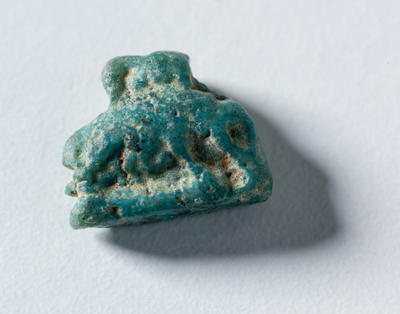Amulet, sky goddess Nut depicted as a sow.
Production date
664 BCE-525 BCE
Country
Egypt
See full details
Object detail
Description
Small blue glazed faience mould made amulet in glazed composition, roughtly made. Flat, regular base. Obverse base contains one longitudinal line with moderate depth. May represent a mammalian animal, standing on a rectangular base, possibly representing the Sky Goddess Nut as a Sow, suckling or swallowing her piglets. Stylised features.
Classification
ARCHAEOLOGY Egyptian amulet
Production date
664 BCE-525 BCE
Production place
Measurements
L9mm x W11mm x D5mm
Media/Materials description
Egyptian faience is a ceramic material with a siliceous body and brightly coloured glaze.
Faience (composed of quartz, alkaline salts [natron or plant ash], lime, and metallic mineral-based colorant)
Glaze (formed by alkali and lime reacting with silica to form the glaze)
Faience (composed of quartz, alkaline salts [natron or plant ash], lime, and metallic mineral-based colorant)
Glaze (formed by alkali and lime reacting with silica to form the glaze)
History and use
Ancient Egyptian beliefs concerning the afterlife are well known. Death was the entering of a new phase of being. Ancient Egyptians believed in many different deities, often represeted by amulets. Amulets served as magical objects, deriving their power from colours, materials and colours They offered protection both in daily life and the hereafter. Amulets were work as jewellery, concealed in clothing, and were placed in the wrappings of the deceased or placed in tombs.
Registration number
E6109.3



